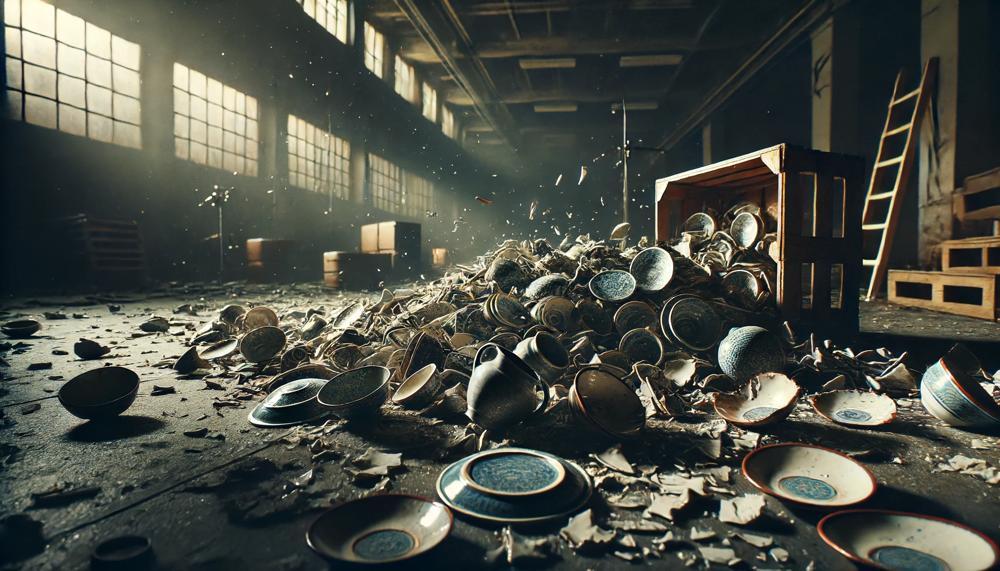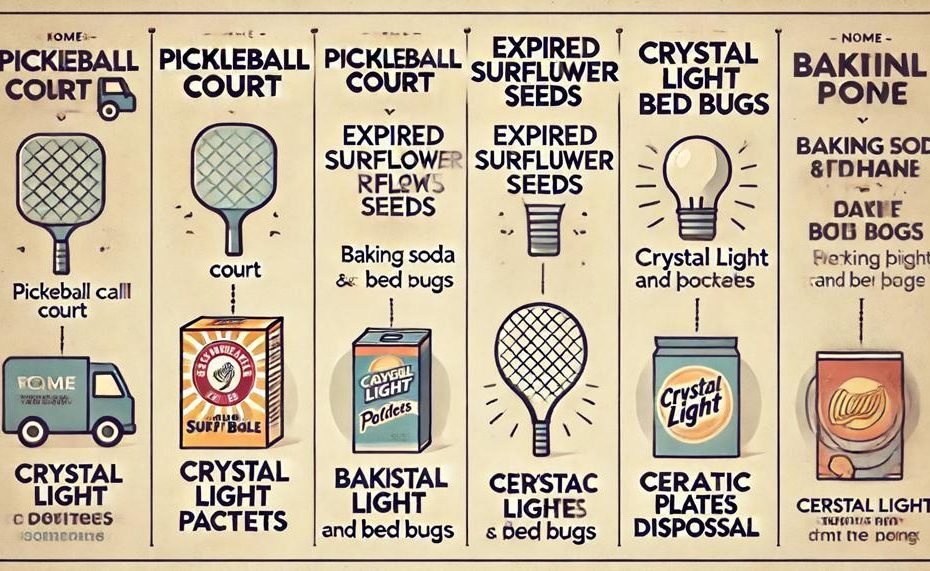Ceramic plates add a touch of elegance to our dining experiences, but what happens when they’ve served their purpose and need to be discarded? Proper disposal is more than just a household chore—it’s a step towards sustainability. Let’s break it down:
If your ceramic plates are cracked or broken, they should go in the regular trash. This is because broken ceramics can be hazardous in recycling facilities. However, if the plates are intact, there are eco-friendly ways to part with them.
First, check if your local recycling center accepts ceramics. If they do, clean the plates thoroughly to remove any food residue. Remember to wear gloves if they have glazes or decorations that might contain harmful chemicals. Place these clean plates in a cardboard box, separate from other recyclables.
No luck with recycling? Donate your usable plates to charities or thrift stores—they might be perfect for someone else’s table. Additionally, some municipalities offer special waste collection services for items like ceramics.
If neither option works, get creative. Use old plates as plant saucers or break them up for mosaic art. This way, they don’t end up in a landfill, contributing to environmental harm.
Key Takeaways:
- Broken or cracked plates: Dispose of in regular trash.
- Usable plates: Check local recycling options or donate.
- Clean plates thoroughly before recycling.
- Use gloves if plates have glazes or decorations.
- Special waste collection services might be available.
- Repurpose plates creatively to reduce landfill waste.
Disposing of ceramic plates responsibly ensures we minimize environmental impact and support sustainable living.
Contents
Tossing Ceramic Plates in the Trash
The proper way to dispose of ceramic plates without harming the environment involves several steps to ensure minimal impact.
Assess Condition
:
- Reuse or Donate: If the plates are in good condition, consider donating them to charities or thrift stores. This extends their lifespan and reduces waste.
- Repurpose: Use unbroken plates creatively in your home, such as for garden markers or craft projects.
Broken or Damaged Plates
:
- Recycling: Check with local recycling centers to see if they accept ceramics. Not all do, due to the material’s composition.
- Alternative Uses: Break the plates into smaller pieces for drainage in plant pots or as a base for garden paths, enhancing soil aeration and reducing waste.
- Composting: Only unglazed ceramic plates should be composted, as they are made from natural materials like clay and sand. Glazed plates can leach harmful chemicals.
Landfill Disposal
:
- If no other options are viable, wrap broken plates in newspaper or place them in a sturdy box before disposal. This prevents harm to waste management workers and machinery.
Avoid Regular Trash
:
- Ceramic plates can break and cause environmental harm if disposed of in regular trash. They can also damage waste management equipment.
Special Disposal Considerations
:
- Some ceramic plates may contain lead or other harmful chemicals in their glaze. Contact your local waste management facility for guidance on safe disposal if unsure.
Recycling Ceramic Plates
Recycling ceramic plates offers numerous benefits and follows a specific process to ensure efficiency and environmental sustainability.
Benefits of Recycling Ceramic Plates
Environmental Benefits:
- Resource Conservation: Recycling reduces the demand for new raw materials, preserving natural resources like clay and minerals.
- Waste Reduction: It minimizes landfill waste, as ceramics can take centuries to decompose.
- Pollution Reduction: Recycling lowers the pollution associated with mining and processing new materials.

Economic Benefits:
- Cost Savings: Manufacturers save costs by using recycled materials instead of new raw materials.
- Job Creation: Recycling processes create jobs in collection, processing, and manufacturing sectors.
- Economic Efficiency: Improved recycling methods can lead to more cost-effective production practices.
Consumer Role:
- Awareness and Participation: Consumers can promote recycling by making informed choices, participating in recycling programs, and understanding local recycling guidelines.
Correct Process for Recycling Ceramic Plates
| Steps | Description | Benefits |
| Separation | Separate ceramics from other waste. | Avoids contamination, improves recycling efficiency. |
| Local Guidelines | Check local recycling rules. | Ensures compliance and proper recycling practices. |
| Community Programs | Engage in local recycling initiatives. | Boosts participation and awareness. |
| Chemical Recycling | Break down ceramics chemically. | Allows reuse in new products. |
| Contamination Control | Identify and remove contaminants. | Ensures high-quality recycled materials. |
| Collection and Infrastructure | Develop efficient collection systems. | Facilitates large-scale recycling. |
By following these steps, recycling ceramic plates can significantly benefit the environment and economy, promoting a more sustainable future.
Donating Ceramic Plates
Donating ceramic plates offers several compelling benefits, particularly when compared to simply disposing of them. Here are some key advantages:
| Environmental Benefits | Community Benefits | Personal Benefits |
| Reduces landfill waste | Supports charitable organizations | Tax deductions |
| Saves energy and resources | Helps those in need | Inspires others to donate |
| Contributes to a sustainable future | Fosters community engagement | Provides personal fulfillment |
Environmental Benefits
Donating ceramic plates significantly reduces the waste that ends up in landfills. According to the Environmental Protection Agency, about 25% of landfill waste consists of food scraps and disposable items.
By choosing to donate, you not only lessen this waste but also contribute to conserving energy and resources needed for manufacturing new plates.
Community Benefits
Charitable organizations such as soup kitchens and homeless shelters heavily rely on donations.
Your ceramic plates can directly aid these institutions, enabling them to provide meals more effectively. This act of kindness supports those in need and strengthens community bonds.
Personal Benefits
There are tangible personal benefits to donating ceramic plates. In many countries, donations to registered charities can be tax-deductible, offering you a financial advantage. Moreover, your actions can inspire others to donate, creating a ripple effect of positive community impact.
Finally, the sense of satisfaction and fulfillment from knowing your plates are serving a good cause is immeasurable.
By donating ceramic plates, you not only help the environment and support your community but also gain personal rewards.
Reselling Ceramic Plates
Properly disposing of ceramic plates for resale involves a few crucial steps to ensure they remain in good condition and attractive to buyers.
| Step | Action | Details |
| 1 | Inspect and Sort | Separate undamaged plates from damaged ones. |
| 2 | Clean Thoroughly | Use warm water and mild soap; avoid abrasive cleaners. |
| 3 | Proper Packaging | Use bubble wrap and packing peanuts; avoid paper. |
| 4 | Resale Options | Sell at garage sales, flea markets, or online platforms. |
| 5 | Donation | Donate to local charities or thrift stores if unable to sell. |
| 6 | Waste Management | Check local guidelines for disposing of damaged plates. |
Repurposing Ceramic Plates
Repurposing ceramic plates can not only give new life to old dishware, but it is also an eco-friendly and budget-friendly option. Here are some creative ways to repurpose ceramic plates:
- Garden edging: As mentioned in the research, garden edging is a popular and practical way to repurpose old plates. By simply knocking them into the soil with a mallet, you can create a stylish border for your garden while also helping retain water and soil.
- Light fixture: Another way to repurpose ceramic plates is by turning them into a unique light fixture. By arranging the plates in any pattern you like and adding a lightbulb, you can create a one-of-a-kind piece for your home.
- Wall art: Use multiple plates to create a stunning wall display. You can paint them in different colors or patterns, or leave them as is for a more vintage look.
- Jewelry holder: Transform an old plate into a beautiful jewelry holder by adding small hooks or using a plate stand to hang necklaces and bracelets.
- Bird feeder: Use a shallow plate as a base and glue a vase or cup in the center for bird food. The plate will catch any seed that falls, making it easier to clean up.
- Coasters: Cut old plates into smaller pieces and use them as coasters. You can even add felt or cork to the bottom to prevent scratching surfaces.
- Table centerpieces: Use stacked plates as a centerpiece for your table, adding candles or flowers on top for a beautiful display.
- Clock: Get creative and turn an old plate into a clock by adding clock hands and numbers.
- Candle holders: Use small plates as candle holders by placing the candle in the center and adding decorative elements around it, such as rocks or shells.
- Mosaic projects: Break old plates into smaller pieces and create mosaic projects such as picture frames, vases, or even a mosaic wall.
- Planters: Create unique planters by drilling a hole in the bottom of a plate and adding soil and your favorite plants.
- Serving trays: Use larger plates as serving trays by adding handles or attaching small feet to the bottom for stability.
- Soap dishes: Smaller plates can be used as soap dishes to add a touch of elegance to your bathroom.
- Wall clock: Similar to the plate clock, you can use a larger plate to create a wall clock by adding clock hands and numbers.
- Picture frames: Use a plate as a frame for your favorite photo by cutting out the center and adding the picture behind it.
- Chalkboard: Turn an old plate into a chalkboard by painting it with chalkboard paint and adding a piece of chalk on top.
- Garden art: Use old plates to create garden art by stacking them in different sizes and heights, adding a decorative element at the top.
Breaking Down Ceramic Plates for Household Uses
Safely and effectively breaking down ceramic plates for household uses involves careful preparation and handling to avoid injuries and ensure proper disposal. Follow these steps to break down ceramic plates:
| Step | Details | Tools |
| Gather Materials | Collect necessary tools and protective gear. | Hammer, Towel, Gloves, Safety Glasses, Dustpan, Brush, Sealed Bag |
| Preparation | Lay towel on hard surface and place plate on top. | Towel, Cloth |
| Breaking Down Plate | Tap edges of plate gently, moving towards center to create cracks. | Hammer |
| Handling Pieces | Break plate into smaller pieces by hand or with hammer’s edge. | Hands, Hammer |
| Clean-Up | Collect debris using dustpan and brush. | Dustpan, Brush |
| Responsible Disposal | Dispose of broken pieces in a sealed bag at a recycling center or landfill. | Sealed Bag |
Breaking down ceramic plates can be done safely and effectively with the right tools and careful handling. Always wear protective gear and handle broken ceramics with caution.
By following these steps, you can dispose of old or damaged ceramic plates properly, ensuring safety and environmental responsibility.
Can Staples Be Recycled?
No, staples cannot be recycled together with ceramic plates. Although both staples and ceramic plates are recyclable, they require different handling and recycling processes due to the differences in their materials.
Recycling Staples and Ceramic Plates
| Material | Recycling Process | Important Notes |
| Staples | Recycled through metal recycling programs or household recycling bins for metals. | Ensure staples are free from paper or plastic attachments before recycling. |
| Ceramic Plates | Recycled through specialized ceramic recycling programs or repurposed as fillers for construction materials. | Check if your ceramic plates are free from harmful chemicals like lead, which may prevent them from being recyclable. |
Is Porcelain Recyclable?
Yes, porcelain can be recycled, but it involves special methods and facilities. Porcelain, composed of kiln-baked clay materials, can be crushed and melted to create new products. This recycling process helps reduce waste and conserve resources.
Examples of Recycled Porcelain Products:
| Product Type | Description | Benefits |
| Tiles | Porcelain tiles are a common product made from recycled porcelain, used in flooring and walls. | Durable, environmentally friendly, and aesthetically pleasing. |
| Toilets | Old porcelain toilets can be recycled and repurposed into new toilet products. | Reduces landfill waste, promotes circular economy. |
| Sinks | Recycled porcelain is used to manufacture new sinks. | Cost-effective, conserves natural resources. |
| Showers | Porcelain from discarded items is repurposed into shower components. | Minimizes waste, supports sustainable practices. |
Conclusion
Disposing of ceramic plates responsibly is a vital step towards sustainable living. When plates are cracked or broken, they belong in the regular trash to avoid hazards at recycling facilities. Intact plates, however, offer more eco-friendly options.
First, check if your local recycling center accepts ceramics. If they do, thoroughly clean the plates and package them separately. If recycling isn’t an option, consider donating usable plates to charities or thrift stores, extending their life and reducing waste.
For creative reuse, old plates can be transformed into plant saucers, mosaic art, or garden borders. This not only prevents them from ending up in landfills but also adds a unique touch to your home or garden.
If all else fails, wrapping broken plates securely before disposal ensures the safety of waste management workers. Always consider local waste collection services, which might have specific protocols for ceramics.
By following these steps, you contribute to environmental sustainability, keeping our planet cleaner and greener.





